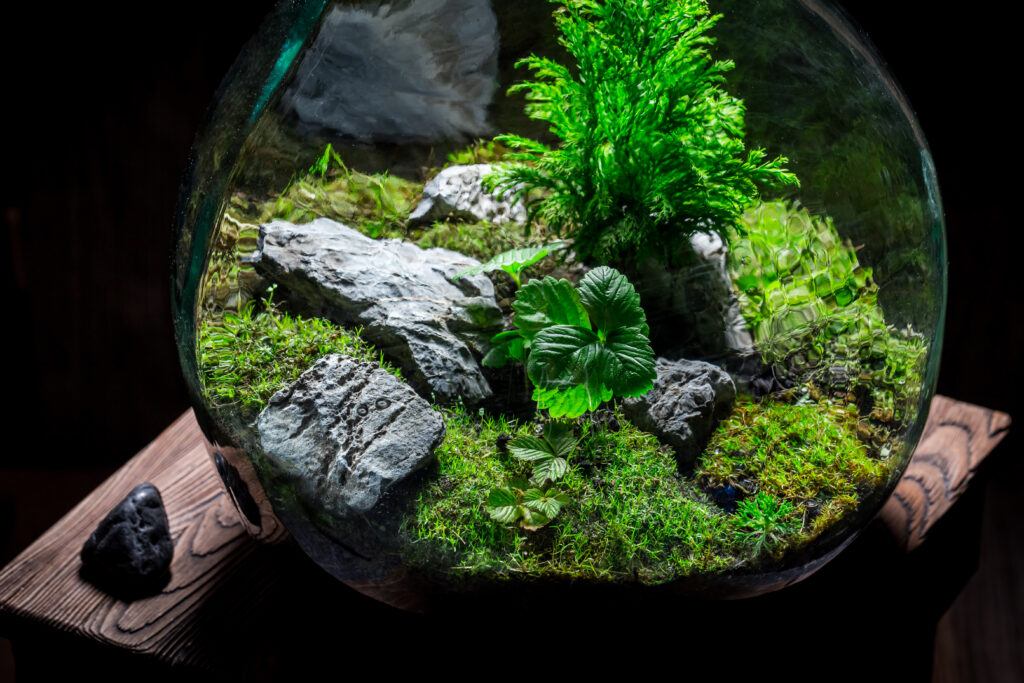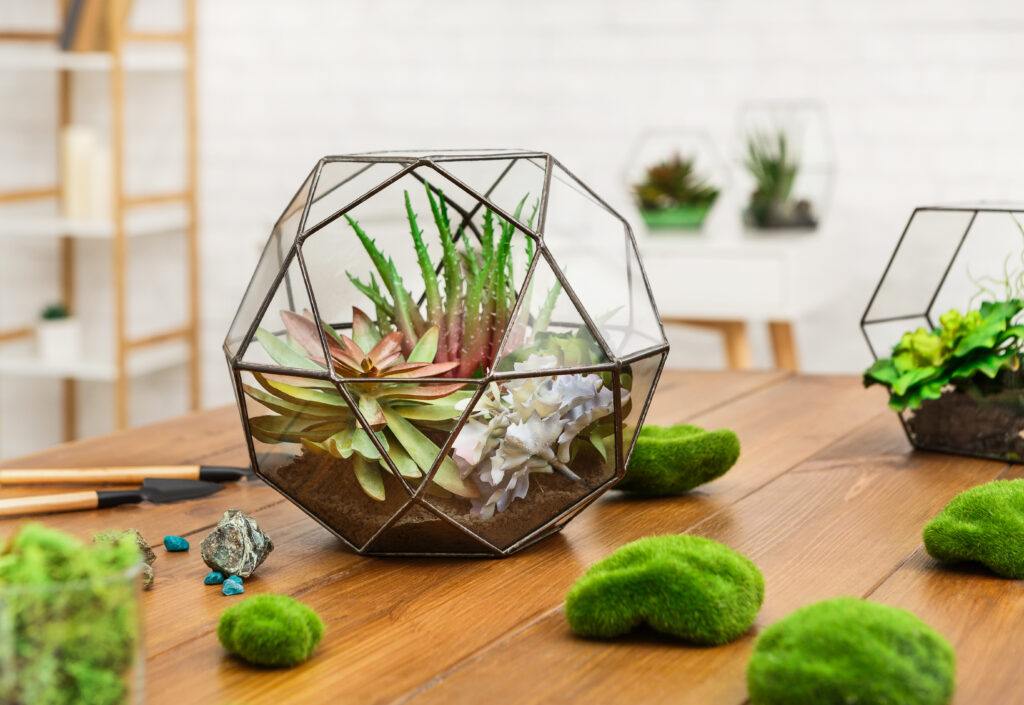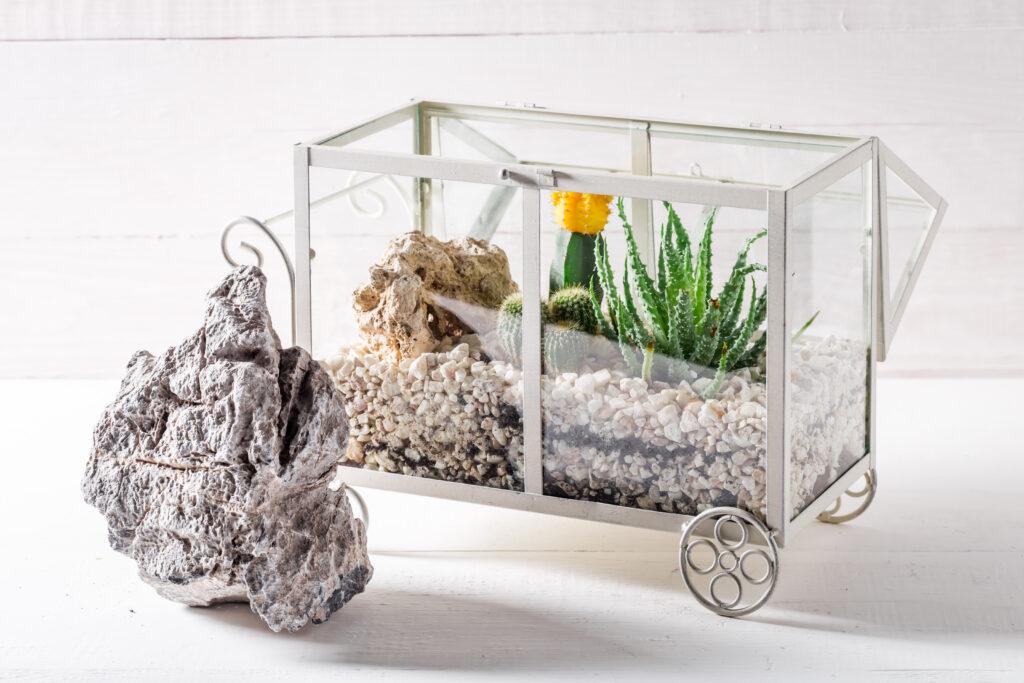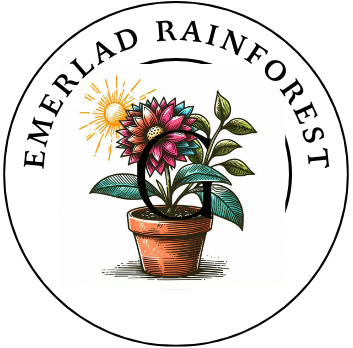
Terrariums have been around since the Victorian era when they were first introduced as a novel way to bring a bit of the green outdoors into homes and offices. They’re kind of like a miniature ecosystem housed in a glass container. They can either be open or closed, which will impact the size and types of plants you choose as well as the humidity inside the terrarium.
If you are wondering what the difference is between terrariums and mini gardens is, the main difference is that terrariums are typically enclosed, creating their own micro-environment, while mini gardens are usually open and can include a wider variety of plants—not just the tropical types often found in terrariums.
Both terrariums and mini gardens offer multiple benefits, such as being low maintenance, making them perfect for busy folks. They can keep your plants alive all year round if properly maintained. Imagine providing a splash of nature by creating a beautiful terrarium for your home and one for your desk at work.
An important part of understanding terrariums is knowing about their internal ecosystem. A closed terrarium, for instance, recycles its own moisture. Imagine tiny clouds raining inside. This unique cycle keeps the plants watered and creates a more humid environment. In an open terrarium, the environment stays drier, which suits plants like succulents. Each type has its own charm and requires specific consideration to thrive.
Building Your Own Terrarium: A Step-by-Step Guide

Creating your own terrarium is a fun and rewarding project. You’ll need some basic materials to start. Most importantly, you’ll want a clear glass container, well-draining potting soil, along with small rocks for drainage, and some activated charcoal to keep things fresh by preventing mold and odors.
Choosing the right container is key and depends on the plants you want to grow. Closed containers are perfect for tropical plants that thrive in humidity, and choosing a wide-mouth container will make it easier to plant. Open containers suit cacti and succulents that prefer a drier environment. You can either purchase a glass container or use one you have on hand such as a mason jar, large brandy sniffer, or a fishbowl. A larger container is easier to work with and will provide more space for your plants to grow.
Setting up the layers properly in your terrarium can make all the difference. Begin with a layer of small rocks to help with drainage, then cover with a thin layer of activated charcoal. Add potting soil on top, ensuring there’s enough room for roots to expand. This layering is essential for supporting a healthy environment for your plants.
When it comes to design, think about how you’d like your little garden to look. Mixing heights and textures of plants can create an eye-catching display. Add decorative elements like small figurines or colored pebbles for a personal touch. Remember, while aesthetics are important, ensuring the plants have enough space and light is crucial for their health.
The Best Plants for a Healthy Terrarium

Picking the right plants can make or break your terrarium experience. Not every plant fits every type of terrarium, so you’ve got to be a bit choosy about what goes in there.
Criteria for selecting ideal terrarium plants revolve around their size, humidity tolerance, and light requirements. Smaller plants with slow growth are preferable, as they won’t overrun the space. For closed terrariums, consider plants like mosses, ferns, and air plants that enjoy higher humidity levels. Open terrariums do well with air plants, succulents and cacti that love airy, drier conditions.
A few top picks for beginners include moss, nerve plants, white butterfly plant, and lemon button fern for closed environments, as they handle humidity well and bring vibrant colors. For open terrariums, Aloe, echeveria, jade plant and other small succulents are hard to beat thanks to their resilience and unique shapes.
While it might be tempting to fill the terrarium with a wide variety of species, avoiding plants that grow too quickly or require significantly different conditions can save you some headaches. Skip large-leafed plants or those needing full sunlight unless you have the room and lighting to accommodate them.
Incorporating a mix of moss, ferns, and succulents can add visual interest and texture to your terrarium. Each has its watering and light needs, so think about how they’ll get along with each other. A bit of planning goes a long way in keeping the setup manageable.
Caring for Your Terrarium: Essential Maintenance Tips

Maintaining your terrarium isn’t a tough job, but it does require some attention to detail to keep things thriving. Light is your first consideration. Most terrariums do best in indirect sunlight. Direct sun can overheat the glass, frying your plants, especially in closed containers.
Temperature and humidity play big roles, too. Closed terrariums create their own humid environment, so they’re less demanding in dry climates. Just make sure they’re not placed near heaters or air conditioners, which could disrupt the balance.
Watering is another critical aspect. Over-watering is a common mistake that can lead to mold or root rot, especially in closed settings. Check the soil moisture about once a week; only water if the soil feels very dry. Open terrariums need even less frequent watering.
Monitoring for pests or diseases is important. Unwanted guests can sneak in with your plants, so give them a good look over before adding them to your setup. Remove any dying leaves immediately to prevent decay from spreading disease.
For long-term care, regularly trim any overgrown plants to maintain their size, and rearrange when necessary to accommodate growth. Keeping your terrarium clean by wiping the interior glass can help light penetrate more effectively, which is vital for plant health.

I loved how you walked through the different types of plants that thrive in these miniature ecosystems and gave practical tips on setting up and maintaining them. The step-by-step approach makes it feel so doable, even for someone like me who’s new to gardening. I’m especially intrigued by the section on choosing the right container—it’s amazing how much impact that can have on the plants’ growth. Do you have any favorite plant combinations that look particularly great together in terrariums? Thanks for such an inspiring and informative guide!
Bob, some of my favorite plants/combinations are white butterfly, moss, string of turtles, fluff ruffles and petite peace lily. There are so many more, and you should add small driftwood, rocks, and other non-living pieces to add texture. Thank you!
I came across this website and found it fascinating. Like you I’m learning to do small things to make my home beautiful. There’s so much to explore here. Kathryn is definitely correct about adding small objects to the design. it’s a way of customizing to your lifestyle and home decor.
Jeff,
Thank you for your comment on my article, “Terrariums and Mini Gardens”. I’m glad you found it fascinating and you are also interested in beautifying your home with plants.